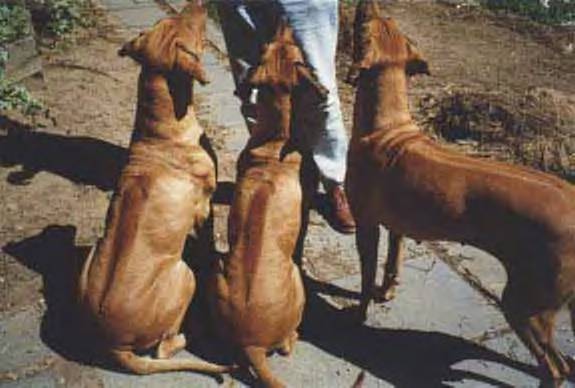
Rhodesian Ridgeback
Veterinarian Reviewed on December 23, 2007 by Dr. Janice Huntingford
Physical Characteristics
Breed Group:
The Rhodesian Ridgeback is a member of the Hound Group.
Weight:
Male: 85 lb.; female: 70 lb.
Height:
Male: 25-27 inches; female 24-26 inches
Color(s):
The coat is light wheaten to red wheaten.
Coat:
The Rhodesian Ridgeback sports a short, dense, glossy coat.
Overview
Character:
This strong-willed breed is loyal and powerful. The Rhodesian Ridgeback may be domineering.
Country of Origin:
South Africa
History:
During the 16th – and 17th-centuries, large dogs accompanied the European Boers settlers to South Africa. The forerunners may include Mastiff, Great Dane, Bloodhound, Pointer, Staghound and Greyhound. The settlers looked to a dog that could tolerate both hot and cold and function as a guard dog and hunting dog. By breeding with the Hottentot tribal hunting dogs that wore a ridge of hair, the Rhodesian Ridgeback developed. In 1870s Rhodesia, this breed hunted large game, including lion.
Name:
Earlier known as African Lion Hound. Also known as Ridgeback, Lion Dog.
Temperament:
This protective breed can be reserved with strangers. Be aware that the Rhodesian Ridgeback may try to dominate humans and dogs. Without exercise, this dog may be bored.
Care:
Training:
Provide extensive and consistent obedience training while the dog is still small. Always socialize this dog with humans and other animals at a young age.
Activity:
Provide mental and physical activities daily. Jogging or hiking provides good exercise. With a history of hunting, this breed is still a keen hunter and watchdog.
Ownership:
Owners need to provide a house and yard where the pet can divide his time. Treat this dog as a member of the family. This housedog should sleep indoors. Although the Rhodesian Ridgeback is good with children, this breed is too boisterous for small children. Do not allow children to pester. Always supervise. This breed offers some protective ability. Males may be aggressive with other dogs.
Breeders:
No breeders listed at this time.
Sign up for our newsletter and receive more articles and the latest pet health updates and special offers.
Our Expert
 Dr. Janice Huntingford
Dr. Janice HuntingfordJanice Huntingford, DVM, has been in veterinary practice for over 30 years and has founded two veterinary clinics since receiving her Doctor of Veterinary Medicine at the Ontario Veterinary College, University of Guelph. She has studied extensively in both conventional and holistic modalities. Ask Dr. Jan

